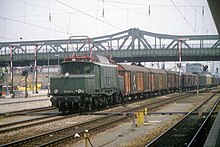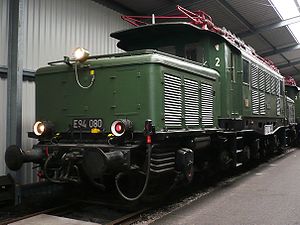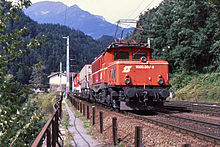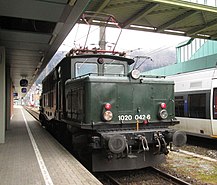DR series E 94
| DRG series E 94 DB series 194 (.5), DR series 254 ÖBB series 1020 |
|
|---|---|
| Numbering: | upon delivery:
after reconstruction:**
|
| Number: | 197 built as E 94 3 built as ÖBB 1020 |
| Manufacturer: | AEG, SSW, Krauss-Maffei, Krupp, Henschel, WLF |
| Year of construction (s): | 1940-1945 1954-1956 |
| Retirement: | 1988 (DB) 1991 (DR) 1995 (ÖBB) |
| Axis formula : | Co'Co ' |
| Gauge : | 1435 mm ( standard gauge ) |
| Length over buffers: | 18,600 mm |
| Trunnion Distance: | 10,000 mm |
| Bogie axle base: | 4,600 mm |
| Total wheelbase: | 13,700 mm |
| Service mass: | 118.7 t / 121.0 t * |
| Wheel set mass : | 19.8 t / 20.2 t * |
| Top speed: | 90 km / h / 100 km / h ** |
| Hourly output : | 3,300 kW / 4680 kW ** |
| Continuous output : | 3,000 kW |
| Starting tractive effort: | 363 kN |
| Performance indicator: | 27.8 kW / t / 27.3 kW / t * |
| Driving wheel diameter: | 1250 mm |
| Power system : | 15 kV 16⅔ Hz |
| Power transmission: | Overhead line |
| Number of traction motors: | 6th |
| Drive: | Paw camp |
| Type of speed switch: | Manually operated cam switch mechanism with additional transformer and fine control, half a turn on the speed step switch means one speed step |
| Brake: | one-way air brake with additional brake, electrical resistance brake Kbr / K-GP mZ (the latter expanded at the DR from 1981) |
| Train control : | Sifa |
| Train heating: | 1000 V 16.7 Hz (originally an additional 800 V) |
| * from E 94 141 ** 194.5 (see text ) |
|
The E 94 series with the nickname "German Crocodile " refers to a series of six-axle heavy electric locomotives of the Deutsche Reichsbahn-Gesellschaft , which were designed for freight train service. When the UIC designation was introduced, it was run as the 194 series of the Deutsche Bundesbahn from 1968 and as the 254 series of the Deutsche Reichsbahn from 1970 , and the 1020 series for the Austrian Federal Railways .
history
The E 94 series electric locomotives were built from 1940 and were designed for heavy freight train service. In addition, they should increase the passability of difficult ramp routes , such as the Geislinger Steige , the Frankenwaldbahn , the Arlbergbahn and the Tauernbahn .
The Co'Co ' locomotives were a direct further development of the E 93 series , from which the E 94 can be immediately distinguished from the outside by the fish-bellied and perforated solebar of the bridge frame and the different arrangement of the side windows and ventilation grilles. The AEG delivered until the end of World War II, 146 of these also KEL (Kriegselektrolok) 2 machines mentioned with numbers E 94001-136, 145 and 151 to 159. When vehicle increasingly called were home materials used. As a war locomotive, its construction was a priority. The locomotives were approved for a top speed of 90 km / h.
The locomotives of the E 94 series were capable of handling freight trains with 2,000 tons on the plain at 85 km / h, 1,600 tons over 10 per mille gradient at 40 km / h, 1000 tons over 16 per mille at 50 km / h and 600 tons over Pull 25 per mille at 50 km / h.
post war period
After the Second World War, most of the locomotives remained with the Deutsche Bundesbahn (DB). Locomotives were made from existing parts even after the end of the war and put into operation at the DB and the Austrian Federal Railways (ÖBB). The ÖBB received a total of 44 machines, which they operated as the 1020 series and which they retired by 1995.
German Federal Railroad

Between 1954 and 1956, the DB had another 43 locomotives with the numbers E 94 178 to 196 and E 94 262 to 285 built and acquired four more from the Deutsche Reichsbahn, so that they had a total of 124 vehicles in stock. 1968 DB drew the E 94 in accordance with its series scheme in the UIC series designation 194 to.
The use of the 194 series on the Bundesbahn was limited to southern Germany. The northernmost and westernmost points of contact were Bebra and Mainz-Bischofsheim. In addition to transporting freight trains, they were also used as push locomotives on the Geislinger Steige and the Spessart ramp.
Eight copies of the stronger sub-series 194.5 (see design features ) were given an additional red marker light for the replenishment service, which saved the train drivers from having to constantly get on and off the locomotive to move the rear window ( Zg 2 ).
Eight further units received a single-arm pantograph for Switzerland in 1987 and were leased to the Swiss Federal Railways (SBB).
The 194 178 was the only locomotive of its series to be repainted in the ocean blue / ivory color scheme that was valid from 1974 (sometimes also called " Blue Mauritius "). In 1988 the use of the 194 series at the DB ended.
German Reichsbahn
19 locomotives remained in the area of the Deutsche Reichsbahn, but 10 of them were defective. The E 94 032 was handed over to the later DB in 1948.
14 copies were shipped to the Soviet Union as reparations after the end of electrical operation in March 1946 . There these locomotives, together with 11 locomotives from the Silesian network , were mostly switched to Russian broad gauge (1520 millimeters) for a test operation near Perm and equipped with SA3 central buffer couplings. The bogies that were not designed for this purpose lost their stability. Because of the lack of space, the wheel stars also had to be turned off.
In connection with the double-track expansion of the Zwickau – Aue – Johanngeorgenstadt line around 1950, there were also plans to electrify it . A total of 16 locomotives of the E 94 were supposed to take over the traffic there for the uranium removal of the SDAG Wismut . However, these plans did not materialize because, among other things, the deposits were less productive than hoped.
In 1952 and 1953, the 25 copies of the Soviet Union were returned to the DR. Because of the changed track gauge, the locomotives were usually dismantled into three parts and loaded onto flat or flat bed wagons. Thus there were 29 locomotives in the damaged park, of which 23 machines could be put back into service from 1956 to 1961.
The modified bogies had to be returned to their original condition, and the machined wheel stars had to be replaced with new parts. The problem with the reconditioning was that the majority of the construction drawings that were also submitted were not returned.
Four E 94 (E 94 042, 046, 054 and 055) were sold to the Deutsche Bundesbahn between 1956 and 1960. Two other locomotives (E 94 007 and 019) were decommissioned due to major damage, served as spare parts donors in the Dessau RAW and were finally dismantled in 1967.
From 1956 the DR started using the E 94 from Bitterfeld , Halle (Saale) , Leipzig-Wahren and Magdeburg-Buckau in heavy freight train service. After the electrification of the Saxon Triangle in 1963, some locomotives were also relocated to Zwickau.
The E 94 had been in service with the DR as class 254 since July 1, 1970. Over the years, the locomotives received new type RBS 58 pantographs and the bogies were painted red.
The first locomotive to be taken out of service on May 30, 1974 was 254 096, which was parked in 1973 after a cable fire. The locomotive involved in the accident 254 017 followed on July 13, 1978. In 1979 the Bitterfeld brown coal combine took over the 254 057 and 058 and used them under its own direction. The Engelsdorf depot east of Leipzig eventually became the discharge depot.
On January 1, 1991, the DR still had eight engines, but these were taken out of service with the exception of the museum locomotive 254 056 in the course of the year. The 254s were nicknamed "Iron Pig" by the DR.
Austrian Federal Railways
Austria was already connected to the Third Reich when the locomotives were planned . That is why it was explicitly planned to use the former Austrian railway network on the Alpine ramps of the Arlbergbahn , Karwendelbahn , Karawankenbahn , Tauernbahn and Brennerbahn as a pulling, pulling and pushing locomotive. From 1940, the Deutsche Reichsbahn put the locomotives into service in the so-called Ostmark (former Republic of Austria) as the E 94 series.
After the end of the war there were 44 locomotives in Austria. In 1953/54 the Austrian Federal Railways (ÖBB) manufactured three more locomotives from parts of the unfinished E 94 146 to 148. There were some deviations from the series that led to the early shutdown of these locomotives. At the same time, the series designation was changed to series 1020 in 1954, whereby the serial numbers were also changed.
The 1020 series was used for decades in freight train and ramp service and was stationed in all important train transports . The locomotives also carried trains to neighboring countries, to Munich , Tarvisio (Italy) and Jesenice (Slovenia).
From 1967 to 1980 almost all locomotives, except for the replicas, were modernized. Among other things, they received two rubber-framed front windows (originally there were three narrow ones), headlight / tail light combinations permanently attached to the stems and nozzle fan grilles on the stems, and from 1970 also a new coat of paint in blood orange instead of pine green.
In 1995 the last locomotives of this series were decommissioned.
Individual vehicles are still in use as museum vehicles, for example the 1020.042-6.
Constructive features
The locomotives have a pawl bearing drive , with the motor and transmission with gear reduction on both sides forming a movable bridge between the unsprung axle shaft and the sprung bogie frame. The middle axis is arranged slightly asymmetrically. The wheel flanges of this axle are weakened by 10 millimeters due to better arcuate mobility. The bogies are coupled to each other to transmit the tensile and impact forces.
The frame is elastically supported on three points on the bogie. The stems rest on the ends of the bogies and house the fans for the outer and middle drive motors, as well as the compressor, main air tank and battery. In addition to the transformer and the switching mechanism, the fans for the internal motors are housed in the machine room. The rear derailleur has 18 continuous speed levels. On the roof there are two pantographs, the resistors for the electric brake and the main switch.
The replicas of the Deutsche Bundesbahn E 94 262–285 received a more powerful Siemens WBM 487 engine, which increased the hourly output to 4680 kilowatts. In the early 1970s, the 194 140, 141, 142, 155, 180, 181 and 182 also received this engine. In the case of the E 94 141, 142, 270 and 271 locomotives, a high-voltage control was installed on a trial basis, in which the speed steps are switched on the primary side of the transformer, making 28 speed steps possible. Since a higher transformer protruding from the roof was required for this, the resistance brake was dispensed with.
At the end of the 1950s, the DB locomotives received larger roof shades over the front windows, and in the early 1960s the third headlight was placed on the front end.
From 1970, the top speed of the locomotives 194 262 to 285 replicated by Siemens and the two later retrofitted with this engine was increased to 100 km / h and they were given the numbers 194 562 to 585 as well as 541 and 542.
Preserved locomotives of the series
Preserved DB locomotives:
- 194 051 is owned by the city of Singen and was used by Pfalzbahn GmbH until 2011
- E 94 080 is in the Bochum-Dahlhausen Railway Museum and is in good condition, but not operational
- 194 158 was created between 1998 and 2001 by the Arbeitsgemeinschaft Historische Eisenbahnfahrzeuge e. V. and is now part of the Rail 4U deployments
- E 94 192 is at the Bavarian Railway Museum in Nördlingen and drives for BayernBahn GmbH
- E 94 279 belongs to the holdings of the DB Museum and is in the care of IG E 94 279 in the Kornwestheim depot
- 194 580 had been with the Glauchau Railway Museum since 1996 and carried out sliding services on the Spessart ramp in order to contribute to their own maintenance. After a refurbishment, it was used for Rail 4U from 2010 . For this it was painted in the former color scheme of the Deutsche Bundesbahn in ocean blue / beige and was given the road number 194 178-0, the only 194 originally repainted in this color variant, also called "Blue Mauritius" . The locomotive has been out of service since June 2013 due to an accident. After being stored in Eisenach, it has been in the Weimar Railway Museum since February 2020 .
- E 94 281 belongs to the inventory of the DB Museum and is available as a spare parts dispenser for the E 94 279 in Kornwestheim
Received DR locomotives:
- 254 040 in the Hermeskeil Museum
- 254 052 Lokwelt Freilassing , Association of Friends of the Historic Locomotive Shed 1905 Freilassing, formerly LEG , currently not operational
- 254 056 belongs to the holdings of the DB Museum and is on the museum track in Leipzig Central Station
- 254 058 in the Falz collection in Falkenberg (Elster) upper station
- 254 059 in the Saxon Railway Museum , Chemnitz -Hilbersdorf
- 254 066 in Hermeskeil
- 254 106 in the Weimar Railway Museum
- 254 110 in the Hermeskeil Museum
Preserved ÖBB locomotives:
- 1020.001 (ex E 94 008) at Metrans in Laa an der Thaya (spare parts donor)
- 1020.003 (ex E 94 011) being processed by the ÖGEG
- 1020.005 (ex E 94 030) at Metrans in Laa an der Thaya (spare parts donor). On March 7, 2020, the locomotive with an inoperable brake was driven from Laa an der Thaya to Hersbruck r. P. convicted.
- 1020.010 (ex E 94 088) operational, 1999 to GES in Kornwestheim, 2018 sold to EZW (Electric Train Funding Württemberg), deployed in southern Germany
- 1020.012 (ex E 94 123) privately owned (spare parts dispenser for 1020.010 / E 94 088)
- 1020.017 (ex E 94 135) Bavarian Railway Museum Nördlingen
- 1020.018 and 1020.023 (ex E 94 001 and E 94 006) at the Association of Railway Friends in Lienz
- 1020.022 (ex E 94 005) at the ÖGEG (spare parts donor)
- 1020.024 (ex E 94 025) at the ÖGEG (spare parts donor)
- 1020.037 (ex E 94 099) operational at the ÖGEG
- 1020.038 (ex E 94 100) in the Strasshof Railway Museum
- 1020.041 (ex E 94 103) at ProLok (ex SLB, ex 2003–2013 at the Mittelweserbahn , until 2012 in push service on the Spessart ramp )
- 1020.042 (ex E 94 104) privately owned by the association "1020.042-6", also equipped with an SBB pantograph and can operate unrestrictedly on the SBB network, stationed in Bludenz.
- 1020.044 (ex E 94 136) at Metrans in Laa an der Thaya
- 1020.047 in the Strasshof Railway Museum , largely restored to its original condition and refurbished and repainted in 2005/06 by the two locomotive supervisors in the Saalfelden train transport center
literature
- Brian Rampp, Dieter Bäzold, Frank Lüdecke: The E 94 series - the German "crocodile" . EK-Verlag, Freiburg 1994, ISBN 3-88255-840-7 .
- German old-style electric locomotives - part 3 . In: Eisenbahn-Kurier Special . No. 37 . EK-Verlag, ISSN 0170-5288 .
- Dieter Bäzold: The E 94/254 series . In: The model railroader . 9 / year 31st transpress Verlag, 1982, ISSN 0026-7422 , p. 9-14 .
- Hans-Joachim Gilbert: Mountaineering Family . In: Modellisenbahner . 6 / year 46. Pietsch + Scholten Verlag, 1997, ISSN 0026-7422 , p. 12-19 .
- Thomas Feldmann: 194 158-2 saved. AGHE Krefeld . In: Lok-Magazin . 245 / year 41. GeraNova Zeitschriftenverlag, 2002, ISSN 0458-1822 , p. 65-66 .
- Thomas Feldmann: Row 194. In the driver's cab . In: Lok-Magazin . 256 / Volume 42. GeraNova Zeitschriftenverlag, 2003, ISSN 0458-1822 , p. 56-59 .
- Joachim Hund: You can't get it small. Successful E 94 model . In: Lok-Magazin . 257 / Volume 42. GeraNova Zeitschriftenverlag, 2003, ISSN 0458-1822 , p. 58-61 .
- Ulf Degener: 1995: Goodbye crocodile. Farewell to the ÖBB series 1020 . In: Lok-Magazin . 280 / Volume 44. GeraNova Zeitschriftenverlag, 2005, ISSN 0458-1822 , p. 66-68 .
- Klaus Eckert, Torsten Berndt: Lexicon of the locomotives . Komet Verlag, Cologne 2005, ISBN 3-89836-505-0 .
- Markus Inderst : Picture atlas of the ÖBB locomotives. All traction vehicles of the Austrian Federal Railways. GeraMond, Munich 2010, ISBN 978-3-7654-7084-4
- Franz Gemeinböck, Markus Inderst : The series 1020. The E 94 of the Deutsche Reichsbahn and its replicas in Austria. Kiruba-Verlag, Mittelstetten 2014, ISBN 978-3-9812977-9-9 .
- Klaus Brochmann: E 93 and E 94: modern old-timer electric locomotives for d. heavy freight train service; DB: 193 u. 194, DR: 254, ÖBB: 1020 . Verlag Klaus Brochmann Heidelberg 1977. Monographic series Lokomotiv-Portrait . DNB 810750686
Web links
- History and life of the locomotives of the class 94/194/254/1020
- IG German Crocodile
- - IG Tauernbahn - maintenance of the E 94 001 / ÖBB 1020.018-6
- Railfaneurope Picture Gallery
- modellbau-wiki: The E 94 in a model
- 194 158 and 580 in use at Rail4U
- The train driver , NDR report from September 6, 2013 about Barbara Pirch and her E 94
- Information on the preserved locomotives of the E 94 series on the "Railway Museum Vehicles" website
- Altbauellok.de Electric Train Promotion Württemberg
- Electric train operation in Silesia - E 94
Individual evidence
- ↑ club 1020.42-6. Retrieved June 8, 2019 .
- ↑ The E 94 series today. deutsches-krokodil.de, October 4, 2012, accessed on September 13, 2013 .
- ↑ www.deutsches-krokodil.de
- ↑ MDR Bahnzeit, episode 52, relevant excerpt available at [1]
- ↑ Series - E 94. Retrieved on September 8, 2019 .
- ^ Eisenbahn-magazin 7/2010, p. 28f. See also: Train of Remembrance , in Die ZEIT, April 18, 2013
- ↑ 194 178 in the Museum Weimar . In: railway magazine . No. 4 , 2020, ISSN 0342-1902 , p. 33 .
- ↑ www.deutsches-krokodil.de
- ↑ Recently transferred to Hersbruck former ÖBB 1020.005-3 April 10th, 2020 Photographed from the platform - Bahnbilder.de. Retrieved August 10, 2020 .
- ↑ www.altbauellok.de










